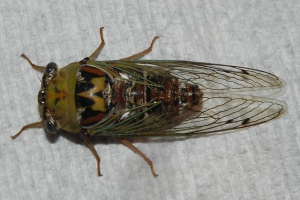Growing up in the city of Houston, I’ve grown to associate hot summer nights with not only the sensation of stifling humidity, but with the sound of hundreds of cicadas deafeningly crying in unison. Well they aren’t so much crying as much as they’re singing for a willing mate via tymbal vibration, but I’ve always imagined sad, desperate critters seeking late night company. A few nights ago on the walk back to my residential college, I heard a familiar deafening plea for attention coming from right underneath me. Naturally startled, I jumped backwards to avoid accidentally stepping on whatever it was that was producing this exceptionally loud sound. To my surprise it was an adult green cicada! I had seen plenty of molts around campus and in my backyard, but I had never seen a live one up close!
Upon closer inspection with my handy phone light, I noticed that it was grounded by some kind of damage. Its wings appeared intact and unharmed, but the cicada was crawling slowly across the dirt. Lacking any entomologist expertise, my gut instinct told me to poke it, so I followed this urge and gently nudged the insect’s abdomen. The cicada went absolutely nuts. It flailed and thrashed, emitting its characteristically loud song, but merely buzzed around in the same spot. I felt sorry for this doomed creature and was ready to rescue it. However, I realized that I have no idea how to repair an insect, or perhaps its broken heart, and my desire to help the insect was instantly outweighed by my desire to add this fascinating specimen to my collection for lab–as horrible as that sounds. All I had with me at the time was my backpack–no net, no bottles, no kill jar. Rummaging through my bag, I found an Altoids container, which I emptied out into one of my bag’s pouches. At this point I had an empty container just big enough to capture this dying insect. As quickly as I could, I threw the box over it, and gently shut it to avoid any damage to its wings or legs. Again, the insect went totally haywire, and I all I could do was make sure the lid doesn’t open to the raw power of a stressed cicada’s wing muscles.
After receiving a few strange looks at my buzzing container, I arrived back at my dorm room, and with some reluctance, placed the container in the freezer to preserve its body for science. Excited from my recent catch, I logged onto my computer to find out more about the specific species I caught. It was an olive green specimen with black and light brown “camo” colorations on the dorsal side of its abdomen and a reddish tinge to its wide-apart eyes. By cross-referencing with Texas Entomology by Mike Quinn (http://texasento.net/), the cicada matched the image and description of the Resh Cicada, whose scientific name is Neotibicen resh. This species can be found across the southern states, such as Texas, Oklahoma, and Louisiana, and an audio recording of its distinctive call as well as a video of its molting process can both be found at the following link to Cicada Mania. (http://www.cicadamania.com/genera/species.php?q=N.+resh)
These insects, of the order Hemiptera, or “true bugs,” derive their name from Latin for “tree cricket” and represent a relatively unchanged morphology for over 250 million years, during which the first fossil Cicadomorpha appeared in the Upper Permian period. This ancient family of insects has widely been featured in literature, such as Homer’s Iliad, and in music, as these are musical creatures themselves. Interestingly, they produce their songs not by stridulation, which is the common way of producing sound by rubbing together certain body parts, but by rapidly vibrating their drumlike tymbals, which are exoskeletal structures located in the membranes of cicada’s abdomen. As cryptic creatures, most cicadas sing at night to avoid predators.
Beyond some of the noise pollution that cicada’s contribute to, cicadas can occasionally act as agricultural pests. While they do not bite or sting and are generally benign to humans, they occasionally outbreak as pests and can drive down crop yields. But on the flip side, cicada’s use as a food product itself can be traced all the way back to Ancient Greek cuisine, and these insects are still eaten today in China as an excellent protein source. These nutrient-rich creatures are part of the ecological foundation for the food web which supports avian, reptilian, amphibian, mammal, and even other insect species, upon which humans rely.
Another fascinating fact about cicadas is that many are periodic, meaning they spend most of their lives as underground nymphs, feeding off tree roots, and emerge after 13 or 17 years as mature cicadas. These nymphs represent a developmental phase in the cicada life cycle, during which cicadas have special forelimbs for digging. Once they mature into the adult form known as an imago, such as the one I found, they live for approximately 4 to 6 weeks, and sing their famous song with hopes to pass on their genes to the next generation of diggers, and ultimately song-singers.
————————————
Sources:
* Cuvier, Georges. (1851) The Animal Kingdom: Arranged After Its Organization, Forming a Natural History of Animals, and an Introduction to Comparative Anatomy. W.S. Orr and Company.
* Gillot, Cedric (2005). Entomology (3 ed.) Springer. p. 213
* “Neotibicen resh” (Haldeman, 1852). cicadamania.com
* “Neotibicen resh”. bugguide.net
* “Periodical Cicada”. magicicada.org
* “Periodical Cicada”. UMMA, University of Michigan.
* Simoons, Frederick J. (1990) Food in China: A Cultural and Historical Inquiry. CRC Press. p. 334.
* Triplehorn, C.A. & Johnson, N.F. (2005). Borror and DeLong’s Introduction to the Study of Insects. Belmont, CA: Thomson Brooks/Cole.



